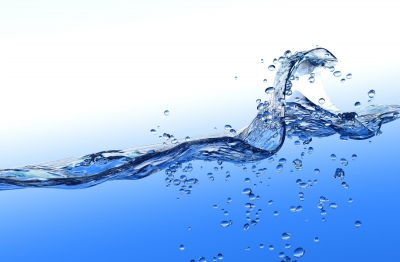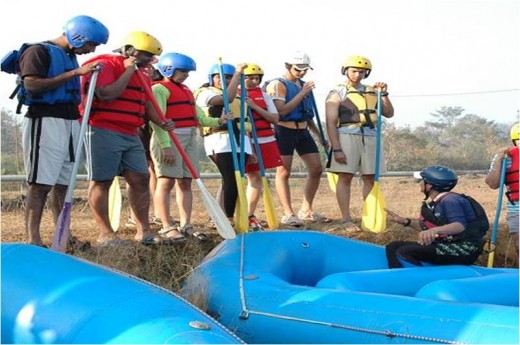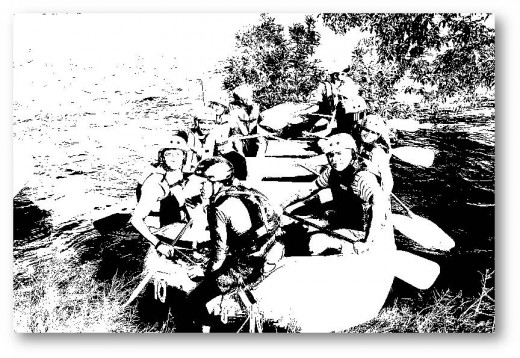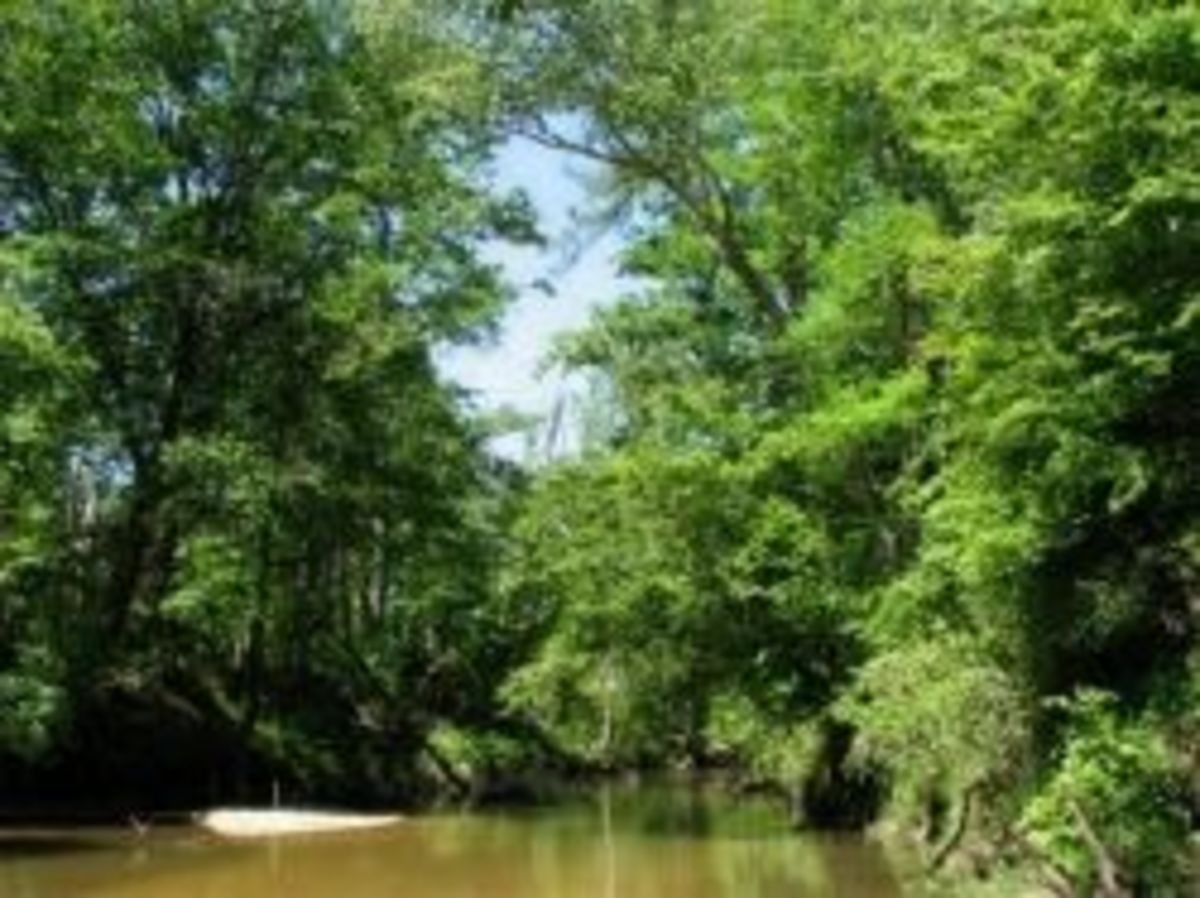How to Dress for River Rafting
I recall these lines from my English course book back in school – I chatter, chatter as I flow to join the brimming river, for men may come and men may go, but I go on forever.-
- From The Brook, 1887 Lord Tennyson
Rivers have been a source of livelihood for many in the generations gone by, most settlements and colonies grew in and around a river source. Besides providing food and water, it was also one of the most important modes of transportation and later a lifeline for trade and commerce. Sometimes flooding of rivers also resulted in wiping out civilizations overnight.

International Scale for River Difficulty (ISRD)
Class I (easy):
Fast moving water with riffles and small waves. The river has few obstructions which are all obvious and easily missed with little training. The risk to swimmers is slight and self-rescue is easy.
Class II (novice):
Straightforward rapids with wide, clear channels which are evident without scouting. Occasional maneuvering may be required, but rocks and medium sized waves are easily missed by trained paddlers. Swimmers are seldom injured and group assistance, while helpful, is seldom needed.
Class III (intermediate):
Rapids with moderate, irregular waves which may be difficult to avoid and which can swamp an open canoe. Complex maneuvers in fast current and good boat control in tight passages or around ledges are often required, strong eddies and powerful current effects can be found, particularly on larger volume rivers. Scouting is advisable for inexperienced parties. Injuries while swimming are rare and self-rescue is usually easy but group assistance may be required to avoid long swims.
Source : ISRD website
In today’s dynamic world, there are people who still make a livelihood from rivers but in a different sense. One of them is camping and adventure agencies or companies that provide a host of fun outdoor activities to enjoy. They organize camping trips, treks & hikes, kayaking ,whitewater river rafting expeditions and rappling on mountain walls, to name a few. It is better to partner with these professional companies when participating in such outdoor activities, since they are knowledgeable and better equipped for the activities and will advise or even provide you with the gear required as a safety mandate for these outdoor adventures.
River rafting first came into prominence as an outdoor recreational activity during the 1970s. Inflatable rafts or boats were used by a group of people who paddled their way through a rather tumultuous river and did it for the sheer joy and excitement as well as the hint of danger involved.
River rafting has different ‘levels’ in terms of difficulty based on the rivers geographic setting which determines the level and speed of the water flowing and the rapids that have to be manoeuvred while rowing through it. The International Scale of River Difficulty provides six different classes or grades for each different level.
Class IV (advanced):
The rapids may feature large, unavoidable waves and holes or constricted passages demanding fast maneuvers under pressure. A fast and reliable eddy turn may be needed to initiate maneuvers, scout rapids, or rest. Rapids may require mandatory moves above dangerous hazards. Scouting is usually necessary the first time down. The risk of injury to swimmers is moderate to high and water conditions may make self-rescue difficult. Group assistance for rescue is often essential and requires practiced skills.
Class V (expert):
Extremely long, obstructed, or very violent rapids which expose a paddler to added risk. Rapids may contain large, unavoidable waves and holes or steep, congested chutes with complex, demanding routes. The eddies that exist may be small, turbulent, or difficult to reach. More difficult Class V rapids may combine several of these factors. Scouting is recommended and may be difficult. Swims are dangerous and rescue is often difficult even for teams of experts. Proper equipment, extensive experience, and practiced rescue skills are essential. There is a large range of difficulty that exists beyond Class IV which makes the difficulty of Class V rapids very diverse.
Class VI (extreme and exploratory):
These rapids have rarely been attempted and exemplify the extremes of difficulty, unpredictability, and danger. The consequences of errors are very severe and rescue may be impossible. These rapids are for teams of experts at favorable water levels. After a Class VI rapid has been run successfully several times, its rating may be changed to Class V.
Source : ISRD website
Most rapids at rivers have names like 'Devils Rock' or 'Tiny Effect' ! So you're guide will announce 'alright folks, get ready to encounter our first rapid 'soft rocks', left front (implying the front left folks better get to work!)
Go for it!
So if you haven’t tried this fun sport before and would like to experience the thrill of being tossed in a raft on a rough river, trying hard to paddle through, breath through the wisps of water spray and just staying on the boat, you need to keep in mind some of the following for a safe and fantastic experience.
What to wear – this will be highly determined by the time of the year you decide to head out rafting. Know that you will be thoroughly drenched, so check for weather and temperature and gauge how cold or warm will the water be. Dress in layers, wear dri fit material (synthetics), one which keeps you warm enough once you’re wet and also dries quickly or even woollens if you rather. A tee shirt and shorts /Bermudas or three fourths are preferable. You can get yourself wet suits if you prefer. Do try and avoid cottons, as they will soak up and remain wet for long, leaving you shivering for a change.
How about my feet?- wear comfortable footwear, shoes you couldn’t care much for if it gets spoilt or floaters (rubber/synthetic sandals) or if you fancy, footwear specific to water sports such as wet shoes.
Cosmetics- apply waterproof sunscreen and lip balm. Keep your palms dry as you need to grip the oars or paddles well for effective rowing.
Preferably avoid any accessories and leave your sun glasses, watch, jewellery etc in a safe pack ashore. You don’t want to risk losing any of those especially when working the rapids when it can get rough.
Carrying some portable water will be a good idea for a long rafting trip, it might be hours before you head back to land.
Fitness-having strong arms and shoulders are a plus, since more of the upper body needs to be exercised for this activity. Otherwise, almost anyone can go rafting.
Listen – Adhere to what the instructor has to say, this is a team activity and everyone has a role, following rules and directions ensures maximum enjoyment as well is essential for the safety of everyone aboard the raft.
All the excitement and fun can make people shout and raise their voices, but always remember to be calm and avoid a racket so that everyone on the boat can hear what the instructor or guide has to say. While having fun, it is vital that the group listens to the guide for the sake of everyone’s safety.
You will also need to help in carrying the raft and securing it properly once the expedition is over. Looking after the raft and maintaining it well, is essential to prolong the life of the raft.

I attended such a camp near Haridwar in India and the video shared below gives an almost similar experience I had. We rafted on the river Alaknanda and the Ganges along the Himalayas during the month of November. We rowed upto Rishikesh and at the confluence of three important rivers called 'Sangam', very sacred to Indians - considering that a dip in it, washes your sins off!
Anyhows, it was cold, yet we were dressed appropriately and enjoyed the entire journey completely. The raft I was on did not flip over, but two others did. We were a six raft team and there was one that was on the rapid, one behind seeing them being tossed and another that had passed them by!
There are enough folks in kayaks around to help when a raft flips over and with your helmets and life jackets on, there isn't much to fear. One just needs to surface up, catch some air, preferable keep hold of your oar and swim back to your raft or wait till the instructor turns it back on. Oars actually play a great role as 'connectors' in reaching out to the folks who are in the water.
Some 'baby' cliff jumps which are part of many rafting expeditions are also shown here.
River rafting & You
What is your opinion on river rafting?

Where to go?
As per the National Geographic, the 10 Best Places for Whitewater Rafting are:
1.Alsek and Tatshenshini Rivers, Alaska/Canada
2. Magpie River, Canada
3. Middle Fork, Salmon River, Idaho
4. Río Upano, Ecuador
5. Futaleufú River, Chile
6. North Johnstone River, Australia
7. Sun Kosi River, Nepal
8. Çoruh River, Turkey
9. Noce River, Italy
10. Zambezi River, Zimbabwe/Zambia
Go Ride the waves!!
Check this video for a feel of it..
Read more on water safety hazards...








